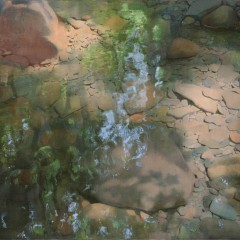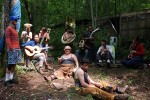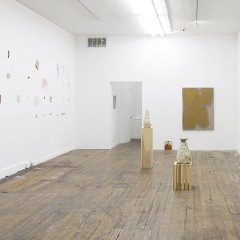In the show called Wax Apple, a plastic orange makes an appearance. It’s not a wax orange, but the echo of the show’s title resounds like the punchline to a joke.
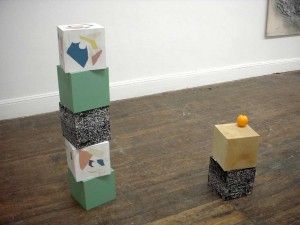
While there are other oranges in this show (a glass vase containing 2 liters of orange soda; a painting and screenprint with a bright orange background) the predominating ambiance of Wax Apple is grayscale—grey, white and black. Even when there is some color it’s monochrome and muted. As one viewer said on leaving the gallery, “That was grim.”
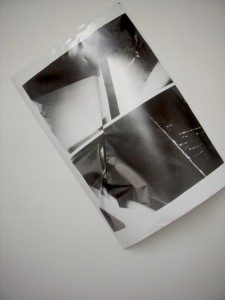
This is a theme show, whose theme has to do with conceptual art. The press release talks about a “renewed enthusiasm” for objects and materials. And while I had trouble finding enthusiasm for the frankly retro-looking and formalist painting, prints, monolithic abstract sculptures and photos, Wax Apple does convey a sense of the importance of art making. And some of the pieces are fun or likable and reverberant of ideas about life.

For example, “Untitled,” that small glass vase with the orange soda. The piece by Christopher Samuels sits like a burst of candy-colored entertainment on the vast gallery floor. Its reference to childhood (does anyone but a child drink orange soda?) and pop culture and consumption triggers thoughts of hot dogs…and Wayne Thibaud’s cake paintings. But, and this may be reading too much into what is perhaps a toss-off work of art, I can’t help but think of the rivers and lakes in Edward Burtynsky’s documentary photos — polluted waters that have almost the same tinge of unreal orange. This jar of colored sugar water will of course get polluted with dust and insects by the end of the show’s run. It may look as toxic as Burtynsky’s rivers. No matter what the artist intends, a viewer can bring a lot to this little piece, and the piece is open enough to give right back.
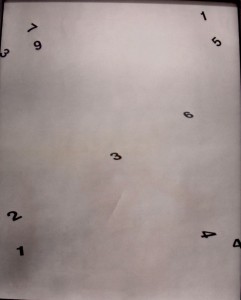
Seven more works in the show (out of 21—there are 16 artists in the exhibit) are also untitled, and many of them are not nearly as engaging. The word “untitled” was prevalent in titling by an earlier generation of conceptual artists and artists whose works are formalist in nature. Today, mostly, artists have moved on from “untitled,” so to see so many untitled’s here is a surprise. Another surprise is the absence of video. Both those things make the show seem old fashioned.

There is what looks like a sad banner for a sad revolution — a piece of cloth, dyed pale yellow, with a dirty yellow stripe across the middle. “Untitled (Golden Yellow, Val Verde, CA)” by Sam Falls is pinned to the wall and sags, and its wordless message is as forlorn as a pee-soaked bed sheet.
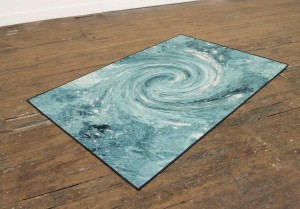
“Portal/Photo Rug” by Kate Steciw is an update on Carl Andre’s minimalist floor pieces. This polyester floor cloth with a photographic image of what looks like the eye of a hurricane seen from a satellite is true to Andre’s aesthetic. It looks precious and you don’t know whether to walk on it or not (when I was there nobody walked on it). I guess that shows you how far we’ve come — not very far. I’ve walked on an Andre rug (you’re allowed), and the sense of iconoclasm—of desecrating a piece of art — is almost thrilling. I assume walking on “Portal/Photo Rug” would give you the same thrill.
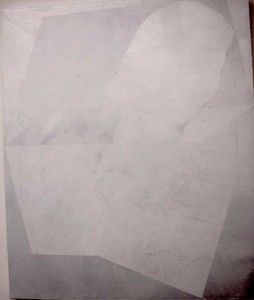
The chill in this show comes from the greyscale works. Ben Schumacher’s “Tractor PTO guard,” an inkjet print on spandex wrapped around a steel armature and his wall piece “BLOCK.PARTITION;” Lucas Blalock’s “Untitled” gelatin silver print; Michael Giudetti’s “Superimposed,” a watercolor on canvas; Collin Hatton’s “Busted,” acrylic and graphite on canvas; Andrea Longacre-White’s inkjet print “Postcard to Heidelberg 4,” Natalie Rognsoy’s “Untitled” watercolor; Jessica Labatte’s inkjet print “Linear Flexing.”

To the uninitiated viewer, these works are formalist enigmas and embodiments of joyless viewing. They may have been fun to make but they don’t engage outside their small conversation circle. Talking with a small audience is fine as far as it goes, but if you’re concerned, as I am, about the chasm between viewers and art that was created by just this kind of art, you will find this show largely disappointing. It’s not enough to make objects – you have to make objects that connect with the public.
See more photos at my flickr. Read this at Philly Weekly (online only)
“Wax Apple,” to July 17.Bodega, 253 N. 3rd St.


